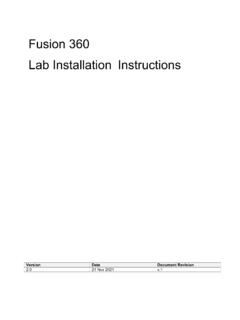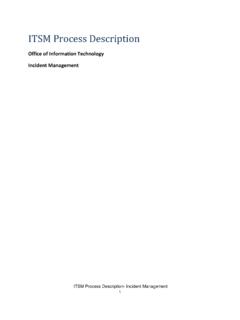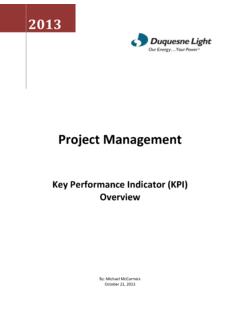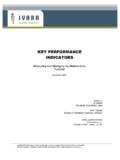Transcription of KPIs of Construction Report - damassets.autodesk.net
1 THE KEY PERFORMANCE INDICATORS OF CONSTRUCTIONSee Ahead Think Ahead Stay AheadResearch conducted in collaboration with Dodge Data & Analytics| Introduction| 7 kpis of Construction1. Problems Discovered in Construction Documentation 2. Logging RFIs & Responses3. Documenting Change Orders4. Updating the Project Schedule5. Software for Safety & Inspections6. Labor Productivity7. Quality & Close-Out| Let s Compare: kpis Side-by-Side| ConclusionMany companies use key performance indicators ( kpis ) to gauge and compare performance in terms of meeting both strategic and operational goals. However, the Construction industry as a whole lacks objective benchmarks, or a way to measure excellence across the industry. The aim of this eBook is to outline simple kpis that companies of all sizes can start capturing today by using technology that digitizes this information and collects it in a central area. The comprehensive analysis of this data across the industry will help improve processes and lead to better performance and project delivery.
2 One reason for the absence of industry benchmarks is the lack of centralized data necessary to establish standards. All contractors using digital technology to manage their Construction projects are generating data and information; however, many say they lack a single place to aggregate that information and knowledge of how to use it in a meaningful way. Having the ability to analyze data, such as project information around requests for information (RFIs) and change orders, not only provides useful context, but also enables contractors to understand patterns of issues in their building commissioned a study with Dodge Data and Analytics to survey more than 200 contractors and trade professionals in order to identify and analyze current processes for planning and executing projects. The study revealed seven key process indicators that companies say are especially useful to interpret overall performance. The findings suggest that by adopting specific processes for project management, contractors can reduce risk, thus minimizing downstream problems and improving performance.
3 The following summary of the Report covers seven categories of project activities, including:1. Problems discovered in Construction documents2. RFIs3. Change orders4. Schedule5. Safety/Inspections6. Labor productivity7. Quality and close-out Read the key findings and see how your company measures up. INTRODUCTIONAUTODESK || THE kpis OF Construction || 37 kpis of ConstructionIn this section, we look at the frequency, value, and difficulties related to errors, omissions, and/or constructability issues discovered in the bid set of Construction documents in order to understand how many contractors are capturing this information and how frequently. More importantly, we look at reporting and how this information is being compared against past similar projects and used to conduct risk reduction | PROBLEMS DISCOVERED IN Construction DOCUMENTS54% frequently* capture errors omissions and constructability issues discovered during the bid set of Construction 47% of respondents frequently compare errors, omissions and constructability issues in Construction documents to past STATS: Of those respondents who are capturing errors, omissions, and constructability issues and comparing them to past projects, 66% are using the findings to mitigate risk on future ones.
4 While it s important to capture issues on current projects, it s equally critical to set up standard processes to compare them to past projects. Why aren t companies recording this data? Just over 50% of general contractors (44% of trades) said the biggest obstacle to capturing this information is how time-consuming or expensive it is, and about one quarter feel they don t have an easy way to do it. However, only 14% of all respondents who are frequently capturing this information on more than half of their projects reported a high/very high degree of difficulty doing so. It seems that once companies get past those initial barriers of cost and adoption, capturing and reporting this information in a succinct way becomes part of their standard operating procedure.*Frequently = on over 50% of their projectsOf those capturing and comparingGC/CMSTRADES55%36%AUTODESK || THE kpis OF Construction || 53 | The findings in this section address the collection and documentation of change orders, including turnaround time, root cause evaluation, and schedule RFIS & RESPONSES 2 |NOTABLE STATS: 73% of respondents are logging RFIs and responses on over half of theirprojects.
5 Trade contractors more frequently Report RFIs to senior management aspotential sources of risk, at 75%, versus 64% of general contractors. Contractors not digitally logging RFIs and responses see the value init, but they find that the obstacles, such as difficulty in adopting andcost of investing, prevent them from implementing the technology andprocesses to support these activities. A study conducted by SMACNA, Making RFIs More Effective, noted thatdesign-build projects where the general contractor closely collaborateswith engineers and architects tend to have far fewer RFIs and resultantchange orders. This is mostly seen in GMP where design intent iscommunicated, but contractors and trades have freedom to design formaximum productivity outcome. Using historical data to identify the root cause of the RFI and measuringtime to receive a response can help contractors see where the potentialbreakdowns in communication are occurring between teams, aidingthem in implementing more efficient practices on future questions in this section sought to determine how frequently respondents log RFIs and responses and how that information is being compared to past similar projects and used to conduct proactive risk create a log of RFIs and 30% are comparing RFI data from past projects36% are Trade Contractors26% are General ContractorsAUTODESK || THE kpis OF Construction || 63 | The findings in this section address the collection and documentation of change orders, including turnaround time, root cause evaluation, and schedule CHANGE ORDERS3 |NOTABLE STATS.
6 64% of respondents typically collect and document change orders on over half of theirprojects, with general contractors capturing this information at a frequency 10% higher thantrades. This trend continues through other data points around capturing root cause, scheduleimpact, etc. If the general contractor has a change order log, some trades may not seethe need to keep one of their own. Analyzing data from change orders can help general contractors assess performance oftrade contractors. What was the root cause of the change order? How long did it takethem to turn it around? This information can help general contractors select the bestspecialty contractor for their project. What s holding them back? According to feedback from the survey respondents, companiesperceive that investing in processes to better capture and document change orders is bothtoo time-consuming and too expensive. Of those who are rarely (on less than 25% of projects) collecting change order information,69% feel if they were able to do this more frequently, it would help them gain a deeperunderstanding of the issues impacting their project delivery findings in this section address the collection and documentation of change orders, including turnaround time, root cause evaluation, and schedule capture the root cause of a change capture start, finish, and turnaround evaluate schedule impact of change || THE kpis OF Construction || 71 | Capturing Errors and Omissions2 | Capturing a Log of RFIs and Responses3 | Collect and Document Change OrdersLET S COMPARE: CAPTURING AND COLLECTING INFORMATION Only 53% of respondents arecapturing errors, omissions, andconstructability issues in the bidset of Construction documents.
7 Dedicating more time andresources to this phase could helpcontractors identify potential risksand issues earlier in the process,potentially leading to a reductionin RFIs and change ordersdownstream, and less disruptionin scheduling and 75% of respondents are creatinga log of RFIs and responses. General Contractors are morefrequently capturing andcollecting data around RFIs,responses, and change orders RFIs and change orders could bemitigated if more time was spentreviewing documentation 64% of respondents indicated that they are frequently collecting and documenting change orders on their projects. What s interesting is that large companies (defined as <$100M) do it at a frequency 10% less than small companies (defined as >$100M in revenue). This trend continues as we look at other change order activities such as capturing turnaround times, root cause, and schedule capturing and collecting critical project information on at least 50% of their projects53%75%64%AUTODESK || THE kpis OF Construction || 83 | The findings in this section address the collection and documentation of change orders, including turnaround time, root cause evaluation, and schedule THE PROJECT SCHEDULE4 |This section looks at responses as they relate to the frequency of updating schedules and other related activities and outcomes, including the impact of STATS: 42% of respondents reported that they updateschedules daily or weekly.
8 Of that percentage, 20% said that they updatethe schedule within 1-2 days of becoming awareof a situation requiring schedule number is extremely low, considering theimportance of capturing schedule changesin a timely manner, allowing for a clearerunderstanding of the status of the project what s completed, what remains, etc. Over half of the respondents (52%) indicate usingoverall and look ahead schedules on more than halfof their projects. These respondents more than likelybelong to companies who are adopting additionalLean practices on their Construction ADDED COSTS FROM OVER-TIME/SECOND SHIFTNEED TO EXTEND THE PROJECT END DATE66% of general contractors are carrying added costs from overtime/second shifts on at least three quarters of their projects due to schedule slippage, with 50% of them needing to extend the project end || THE kpis OF Construction || 93 | LET S COMPARE: REVIEWING PAST PROJECT INFORMATION 47% of respondents indicated they are looking at errors discovered during constructability reviews on past projects to find patterns and trends.
9 If 30% of companies increased the frequency of reviewing past information for these activities, they could perhaps mitigate issues that occur during the build phase, such as schedule slippage and change Per the Report , only 30% of respondents are looking at historical information, such as RFIs/response times, from past projects and comparing those findings to less than half of their current ones to identify trends and capturing critical project information on at least 50% of their projects. We see that a high percentage (72%) of companies review documents to uncover the root cause of change orders on over half their projects. Reviewing root causes could help prevent the same errors from repeating by enabling companies to catch them earlier in the design | Capturing Errors and Omissions2 | Capturing a Log of RFIs and Responses3 | Collect and Document Change Orders47%30%72%AUTODESK || THE kpis OF Construction || 103 | The findings in this section address the collection and documentation of change orders, including turnaround time, root cause evaluation, and schedule FOR SAFETY & INSPECTIONS5 | This section asked respondents if and how they are using software to manage safety and/or inspections for their Construction of large general contractors are utilizing software to manage safety and/or inspections on at least half of their of general contractors and trades feel using software to manage safety and/or inspections duringconstruction is of high value to improving this see a significant drop in software use by trade contractors (19%).
10 NOTABLE STATS: AUTODESK || THE kpis OF Construction || 113 | LABOR PRODUCTIVITY6 | In this section, respondents highlighted the top factors that they felt decreased labor productivity. Additionally, trade contractors were asked about their prefabrication Productivity When it comes to top factors decreasinglabor productivity, more trades (68%)point to poor schedule management. On the other hand, 60% of generalcontractors see problems withcoordination and communicationbetween project team members andissues with the quality of contractdocuments as the key contributors todecreased labor productivity. Better communication between allproject stakeholders and making surepeople across the organization, areconnected to the information they needcan be considered crucial componentsfor improving with coordination and communication between project teamsProblems with the quality of contract documentsPoor schedule managementProblems with quality managementProblems with issue managementChange orders62%56%61%45%53%68%41%46%39%38%36%4 1%GC/CMTradeAUTODESK || THE kpis OF Construction || 126 | In this section, respondents highlighted the top factors that they felt decreased labor productivity.














